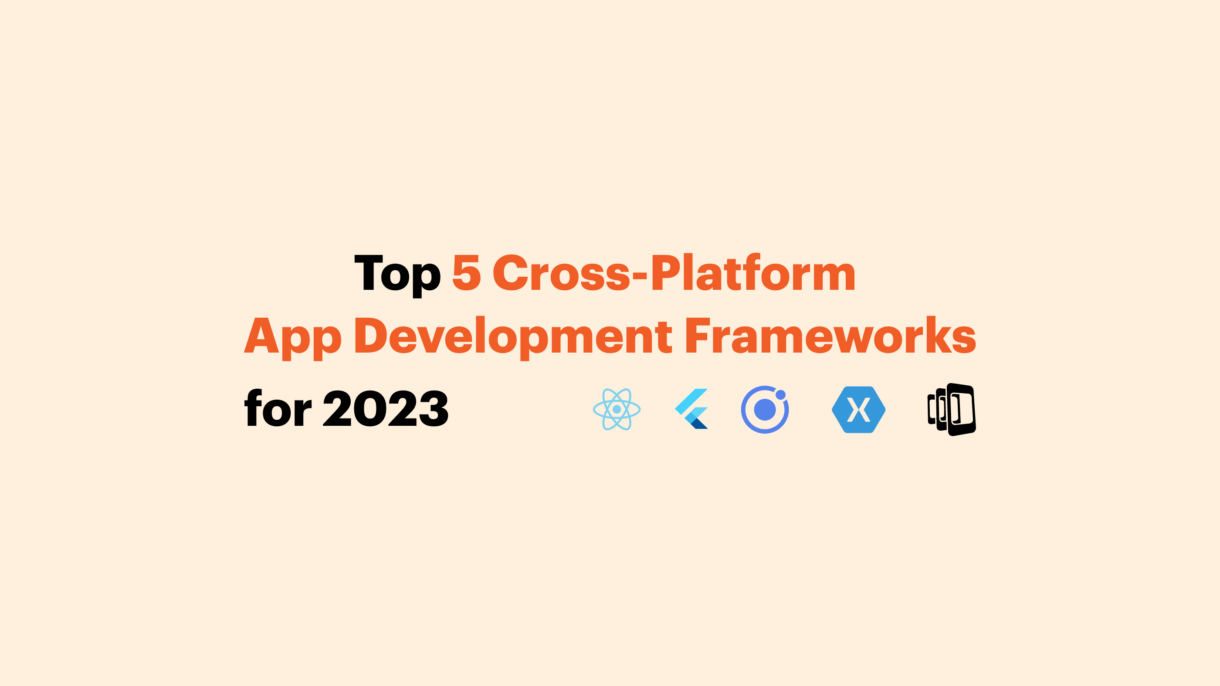Cross-Platform App Development: A Comprehensive Insight
“Design is not just what it looks like and feels like. Design is how it works.”
Steve Jobs
A famous quote by Steve Jobs illuminates this context perfectly. This sentiment underscores the essence of cross-platform app development—it’s not merely about creating an app that’s operational on multiple platforms but ensuring it delivers optimal performance and user experience.
According to a Statista report, the Google Play Store boasts over 3.5 million apps, while the Apple App Store is home to over 1.6 million. Beyond these behemoths, platforms like Windows, Linux, and macOS host a plethora of applications, each catering to a distinct user base. In this diverse ecosystem, absence from a single platform equates to a missed opportunity to connect with millions of potential users.
The conundrum for developers and businesses alike has been the daunting prospect of managing separate codebases for different platforms, a task both resource-intensive and complex. This has often deterred companies from venturing into multi-platform app development.
Enter the realm of cross-platform app development—a harmonious blend of versatility and efficiency. This approach has mitigated the challenges associated with multi-platform presence, yet it is not without its concerns. Performance, a pivotal aspect of user experience, often emerges as a point of contention.
Is the apprehension about performance hampering your journey into the world of cross-platform apps?
Consider this: tech giants and industry leaders like Google Pay, eBay, Netflix, Alibaba, and even segments of Facebook and Instagram have seamlessly integrated cross-platform development frameworks. These apps stand as testaments to the efficacy and reliability of cross-platform solutions, underscoring that with the right tech stack and optimization, they can rival the performance of native apps.

In the ensuing sections, we will delve deeper into the intricacies of cross-platform development, shedding light on its evolution, current trends, and future trajectory. Armed with this insight, you will be better positioned to navigate the complex yet rewarding landscape of app development that transcends platform boundaries, connecting you with a global audience.
If you have any question, feel free to contact us.
Decoding Cross-Platform App Development

Unraveling the Essence of Cross-Platform App Development
Cross-platform app development is the art and science of crafting applications compatible with multiple operating systems. While native app development is intricately tied to tools and languages specific to an operating system – Java and Kotlin for Android, Objective C and Swift for iOS – cross-platform development breaks these silos. It leverages a universal language, ensuring the app runs seamlessly across diverse platforms, making codebase management a breeze.
The Hurdles and Triumphs
However, it’s not a journey without challenges. Cross-platform apps sometimes grapple with limited access to native components, a factor that can potentially dampen performance. But as technology evolves, so do solutions to these challenges, ensuring that cross-platform apps are continually enhancing their performance and user experience.
The Linguistic Landscape
In the world of cross-platform development, languages like JavaScript, C#, and Dart reign supreme. They are the linchpins that hold the architecture together, ensuring that the apps are not just operational but optimized across platforms.
Frameworks: The Unseen Bridge
Frameworks are the unsung heroes in this narrative. Every operating system is a unique ecosystem, each with its set of rules, APIs, and UI components. Frameworks navigate this diversity, ensuring that the developer’s code is not just compatible but optimized for the underlying system.
Developers, armed with frameworks, are liberated from the intricacies of native languages of the targeted OS. Frameworks provide an abstraction layer, a veil that conceals the complexities, enabling developers to code in a language they are comfortable with. While the use of native languages isn’t entirely eliminated, frameworks ensure they are minimized, optimizing the development process.
These frameworks are equipped with pre-built tools and libraries, epitomizing efficiency. They ensure that developers achieve more with less, optimizing both time and effort.
Navigating the Elite: Top Frameworks for Cross-Platform App Development in 2023
The trajectory of cross-platform app development is ascending, a trend mirrored by the proliferation of frameworks designed to optimize this development landscape. Each framework is a unique blend of innovation, efficiency, and adaptability, crafted to cater to diverse developmental needs and objectives. As we sail into 2023, let’s unveil the frameworks that are not just popular but are shaping the future of cross-platform app development.

In the ecosystem of app development, choosing the right framework is akin to selecting the right foundation stone. It’s a decision that influences not just the development process but the performance, adaptability, and user experience of the app. In the dynamic landscape of 2023, where technology and user expectations are evolving at warp speed, these frameworks are the allies that ensure your apps are not just current but are future-ready.
“Innovation distinguishes between a leader and a follower”
Steve Jobs
This sentiment encapsulates the essence of these frameworks – each is a paradigm of innovation, ensuring that cross-platform app development is not just feasible, but efficient, effective, and exemplary. Let’s dive deep into the offerings that are not just making waves but are setting the benchmarks in the cross-platform developmental ecosystem.
React Native: Unleashing the Power of Seamless, Dynamic App Development

React Native, birthed by Meta (formerly Facebook), stands as a testament to the prowess of open-source innovation in the realm of cross-platform app development. Since its inception in 2015, it has carved a niche, blending the richness of the React library with the efficiency of native development, offering a symphony of performance, adaptability, and aesthetic appeal.
“The secret of change is to focus all of your energy, not on fighting the old, but on building the new”
Socrates
A potent quote by Socrates, resonates with the ethos of React Native. It’s not just about transcending the boundaries of traditional app development but about crafting experiences that are immersive, intuitive, and impeccable.
A Closer Look at React Native’s Journey and Ecosystem:
Language: JavaScript
Illustrious Applications: Skype, Bloomberg, and integral components within the ecosystems of Facebook and Instagram, among others.
Dive into the Features that Elevate React Native to a Pedestal:
-
JavaScript Empowerment: React Native is a canvas where JavaScript’s versatility meets the precision of native development, enabling the creation of applications that are as performant as they are dynamic.
-
Community and Support: Nestled under the wings of Facebook, React Native is nurtured by a community that is vibrant, innovative, and collaborative. Every challenge met is a solution birthed, thanks to the collective intelligence and innovation of this global community.
-
Native-Like Prowess: Applications crafted with React Native are not just about cross-platform compatibility; they are about offering user experiences that are indistinguishable from native apps, ensuring users are treated to responsiveness, fluidity, and aesthetic excellence.
-
A UI Paradigm: At the core of React Native is an unwavering focus on user interface design. Every component, every interaction is crafted to ensure users are not just using an app but are immersed in an experience.
-
Fast Refresh: In the dynamic world of app development, agility is king. React Native’s Fast Refresh ensures that every code modification is instantly reflected in the app, ensuring developers are building in real-time, enhancing efficiency and productivity.
-
Component Reusability: Efficiency is woven into the fabric of React Native. Components used recurrently throughout the app can be reused, ensuring development is not just rapid but is also consistent in performance and aesthetics.
In the world where the blend of innovation, efficiency, and user experience defines the success of app development, React Native stands as a beacon, illuminating the path to crafting apps that are not just functional but are experiences, journeys, and narratives unfolding in the hands of users. Every feature, every component is a chapter in this narrative, ensuring users are not just engaged but are enchanted.
Flutter: Orchestrating Multi-Platform Mastery with Google’s Innovation

Flutter emerges as a masterpiece of Google’s innovation, a symphony of speed, efficiency, and adaptability in the realm of multi-platform app development. In the hands of developers, Flutter transforms into a wand, weaving applications that are not just cross-platform but are imbued with native-like finesse, performance, and responsiveness.
“Code is like humor. When you have to explain it, it’s bad”
Cory House
Quoted by Cory House, illuminates the essence of Flutter. It’s an ecosystem where code transforms into experience, seamlessly, intuitively, and dynamically.
Flutter’s Landscape:
Language: Dart
Iconic Applications: eBay, Alibaba, Google Pay, and the suite of ByteDance apps are testimonies to Flutter’s prowess and adaptability.
Unraveling the Features that Define Flutter’s Excellence:
-
The Dart Advantage: Flutter is the realm where Dart, a language crafted for client-optimization, reigns supreme. It’s not just about multi-platform development; it’s about ensuring every interaction, every response, is swift, seamless, and smooth.
-
A Single Codebase Symphony: Flutter is not just a development framework; it’s an ecosystem where a single codebase unfolds into applications across six platforms, a melody of efficiency, consistency, and performance.
-
Hot Reload Magic: Every code alteration transforms into a real-time visual modification, thanks to Flutter’s hot reload feature. It’s a canvas where development and visualization dance in unison, ensuring applications are crafted with precision and agility.
-
A Widget Wonderland: Flutter’s widget library is a treasure trove, offering developers an arsenal of tools to craft, customize, and captivate. Every widget is a building block, ensuring applications are not just functional but are visual narratives.
-
Google’s Patronage: Nestled under the wings of Google, Flutter is not just supported but is nurtured, evolving continuously to meet the dynamic needs of the contemporary app development landscape.
In the galaxy of app development, Flutter shines as a star, illuminating the path to crafting applications that transcend boundaries of platforms and performance. Every line of code is a step towards an experience that enchants, engages, and elevates, ensuring users are not just spectators but are participants in a narrative where technology and experience converge into artistry.
Kotlin Multiplatform Mobile: Unleashing Cross-Platform Innovation with Elegance
Kotlin Multiplatform Mobile (KMM), birthed from the innovation labs of JetBrains, emerges as a paradigm of elegance, efficiency, and excellence in the world of cross-platform app development. It’s where the sophistication of Kotlin, a language renowned for its brevity and power, converges with the versatility of cross-platform innovation.

As the renowned software engineer, Robert C. Martin, once said,
“Truth can only be found in one place: the code.”
Robert C. Martin
In the realm of Kotlin Multiplatform Mobile, this truth unveils itself in applications that are not just functional but are epitomes of performance, adaptability, and user experience.
Kotlin Multiplatform Mobile’s Landscape:
Language: Kotlin
Notable Applications: The digital footprints of Philips, Baidu, Netflix, and Leroy Merlin are embellished with the elegance of applications crafted with KMM.
Exploring the Distinctive Features of KMM:
-
Android’s Native Prodigy: Kotlin, as the native tongue of Android, ensures that applications are not just cross-platform but are imbued with a native touch, especially on Android ecosystems.
-
The Elegance of Brevity: In the world of KMM, codes are sonnets, concise yet powerful, ensuring every feature, every functionality, is crafted with minimalism yet embodies maximal performance.
-
Null Safety and IDE Support: With features like null safety and robust IDE support, KMM stands as a fortress of reliability and developer-friendly ecosystems.
-
The Native Components Advantage: KMM is a bridge where the islands of iOS and Android meet, ensuring developers can harness native components, unfolding applications that are universal yet native in essence.
In the narrative of cross-platform app development, Kotlin Multiplatform Mobile stands as a chapter where the boundaries between native and cross-platform are not just blurred but are artistically merged. Every application birthed from KMM is not just a solution but is a narrative of elegance, efficiency, and excellence, where users are not just consumers but are participants in an interactive, immersive, and intuitive digital journey.
.NET MAUI: A Tapestry of Elegance and Efficiency in Cross-Platform Development
.NET MAUI, evolving from the roots of Xamarin, unveils a world where the elegance of XAML and the efficiency of C# converge to craft cross-platform masterpieces. It’s a domain where the boundaries between different operating systems blur, unfolding a universal canvas for developers to paint their digital artistry.

As Steve Jobs, the pioneer of the contemporary app ecosystem, eloquently stated,
“Design is not just what it looks like and feels like. Design is how it works.”
Steve Jobs
In the world of .NET MAUI, this philosophy finds its true embodiment. Each application is not just a visual delight but a symphony of form and function, aesthetics and performance, innovation and usability.
The .NET MAUI Landscape:
Language: XAML, C#
Hallmark Applications: The digital symphonies of TenScent, UPS, Ernst & Young, and Delta are compositions crafted with the elegant notes of .NET MAUI.
Navigating the Features of .NET MAUI:
-
Universal Appeal: .NET MAUI is not just a framework but a universal key, unlocking the gates of Android, iOS, macOS, and Windows with equal elegance and efficiency.
-
The Layout Engine: With .NET MAUI, each page is a canvas where the layout engine unfolds the artistry of UI/UX, ensuring every interaction is not just functional but is a visual and interactive delight.
-
Native Device Access: APIs in the arsenal of .NET MAUI ensure that applications are not just cross-platform but are imbued with the native touch, accessing device components with precision and efficiency.
-
Hot Reload: In the dynamic world of app development, .NET MAUI’s hot reload feature is the ally of agility, where every code modification is instantly reflected, ensuring rapid development and iteration.
In the echo chambers of cross-platform development, .NET MAUI resonates as a melody of mastery, where every line of code weaves a narrative of innovation, every feature is a testament to versatility, and every application is a journey where users traverse through the seamlessly integrated landscapes of Android, iOS, macOS, and Windows. It’s not just about coding apps; it’s about crafting experiences, weaving narratives, and unfolding digital epics where every click, every swipe, is a stanza of an unfolding story of interactive elegance.
Cordova: Unleashing the Symphony of Web Technologies in App Development
Cordova, a name synonymous with the harmony of flexibility and functionality, stands as a beacon in the open-source mobile app development landscape. It’s where the fluidity of web technologies like HTML, CSS, and JavaScript finds a canvas to paint applications that are not just cross-platform but are imbued with a native touch.

In the words of Tim Berners-Lee, the inventor of the World Wide Web,
“The Web as I envisaged it, we have not seen it yet. The future is still so much bigger than the past.”
Tim Berners-Lee
Cordova is a manifestation of this vision, where the expanse of the web transcends browsers and embeds itself into the heart of applications, making them as universal as the web itself.
The Cordova Chronicles:
Language: HTML, CSS, JavaScript
Showcase Applications: The digital prowess of giants like Adobe, the entertainment hub of JustWatch, and the retail giant Walmart are crafted with the artistic strokes of Cordova.
Unraveling the Cordova Tapestry:
-
Web Technologies Unleashed: Cordova is a realm where the elegance of HTML, the styling prowess of CSS, and the dynamic nature of JavaScript converge to craft applications that are as universal as the web and as specific as native apps.
-
API Access: With Cordova, the boundaries between native and web blur. Its arsenal of APIs ensures that applications, though crafted with web technologies, access native components with native precision.
-
Offline Harmony: In a world where connectivity can be capricious, Cordova ensures continuity. Applications crafted with it are not just about real-time interaction but ensure that users can access cached content, making every app a blend of the live and the cached, the real-time and the retained.
In the unfolding narrative of cross-platform app development, Cordova is a chapter where the elegance of the web and the functionality of native apps weave a narrative of innovation. Every application crafted with Cordova is a journey where the universal appeal of the web and the specific touch of native interfaces coalesce, offering users an experience that’s as fluid as browsing a website and as intimate as navigating a native app.
Closing Thoughts: Navigating the Crossroads of App Development Choices
“The art of life lies in a constant readjustment to our surroundings.”
Kakuzo Okakura
In the intricate dance of technology and innovation, adaptability is the silent melody that orchestrates the evolution of remarkable solutions. The realm of app development, vibrant and dynamic, is a testament to this adaptability, offering a spectrum of pathways from the specificity of native development to the universality of cross-platform frameworks.
A Comparative Lens:
Native app development, with its bespoke approach tailored to the unique architectures of varied platforms, offers precision and performance. Yet, it is akin to weaving separate narratives for each platform, demanding expertise, time, and resources.
On the flip side, the symphony of cross-platform frameworks is a harmonious tune of universality. A single narrative, fluid and adaptable, resonating across platforms, echoing the melody of efficiency, and the rhythm of cost-effectiveness.
The Choice Conundrum:
The crossroads of choice between native and cross-platform is not just a technical decision but a strategic one. It’s where the meticulous precision of native interfaces dances with the expansive embrace of cross-platform frameworks. Every choice is a step in the intricate dance of aligning business goals, resource allocations, and user experience aspirations.
In the grand narrative of app development, where innovation is constant, and evolution is inevitable, every choice, every decision is not a final destination but a stepping stone. The future of app development is a canvas where the distinct strokes of native precision and cross-platform flexibility will continue to paint a picture of infinite possibilities.
As we fold the chapters of this exploration, remember, in the dynamic universe of app development, every choice is right as long as it resonates with the unique melody of your business needs, resource allocations, and the aspirational echoes of your target audience. The dance floor of innovation is open, vibrant, and inviting – every step, every move is a dance in the endless ballet of technological evolution.



